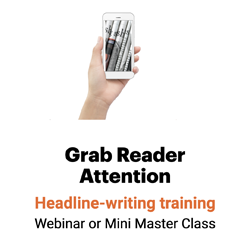Because 57% of news audiences read little else

Consider the numbers:
- Readers spend 56% more time looking at headlines than at text, according to the Eyes on the News study by The Poynter Institute.
- Some 57% read just the headlines, the headlines and a sentence or two or headlines and just one or two stories, according to a Harris Interactive poll.
- A catchy headline in the No. 1 way to get audience members to read your news, according to the Harris research.
How do you read the news — in print or online? |
||
| Item | Total % | |
 |
I normally just read the headlines, but maybe one or two stories in full | 34 |
 |
I skim the full article | 25 |
 |
I read every word in the article | 19 |
 |
I normally will read the headlines and a few sentences into most stories | 15 |
 |
I normally read just the headlines | 8 |
| Source: Harris Interactive Poll Note: Responses may not add up to 100% due to rounding |
||
That means the best way for you to get the word out in your press release is through your headline. And, if you don’t get attention by writing a great headline, your audience may never read the rest of the press release.
So how do you do that? Here are 7 steps for writing great press release headlines:
1. Focus on your readers.
Too many communicators (and, let’s be honest, their reviewers) believe that the company or its product or service is the topic of the release. But the real topic is the reader or what the reader can do.
Just listen to what journalists say:
- Journalists’ biggest pet peeve: releases that aren’t relevant to the target audience. — Greentarget survey of journalists
- “The St. Louis Post-Dispatch did a study in which interviewers asked readers who or what was most important to them. Their answer was surprising. Many did not say their families, children or God. Instead, their answer was: ‘Me.’” — Dick Weiss, St. Louis Post-Dispatch
- “There’s nothing wrong with a story about a new product. But readers want to know, ‘How am I going to use it?’ I’m not interested in ‘new and improved.’” — Stephany Romanow-Garcia, senior process editor, Hydrocarbon Processing
- When asked how to get a release covered by Forbes, Bruce Upbin, senior editor at Forbes, replied, “Present the key element that explains how your story can benefit Forbes readers.”
- “What I really like about a release is when it scratches my reader’s itch and not your client’s itch.” — a trade journal editor quoted in PRSA’s Tactics
Despite all of this, “Organizations write press releases for themselves, not for readers,” writes frustrated PR pro.
Well, not all organizations. While I still see “XYZ Company announces ABC” as the headline in Everybody’sNewsroom.com, at a much higher level, PR pros are using what I call Selfish Altruism. That is, they’re writing about the end user, not themselves. And in doing so, they are getting more coverage, engagement and bottom-line business results for their releases.
Who are those folks? PRSA Silver Anvil Award-winners.These pros earn top national awards for campaigns that earn their organizations money, get laws passed and otherwise change behavior. Not for clicks, clips and comments — but for bottom-line business results.
So why not steal best practices from the top-performing P.R. campaigns in the country? Here’s what I see at that highest echelon of press releases:
Blood cancer patients and advocates visit Capitol Hill to inspire continued support for Be the Match
July 18 Legislative Day event aimed at delivering more cures to patients in need
10 million taxpayers face an estimated tax penalty each year
Act now to reduce or avoid it for 20xx; new webpage can help
Parents and teen drivers dangerously disconnected
New State Farm survey reveals an alarming gap between parents’ and teens views on driver safety licensing laws
Take a tip from these Silver Anvil Award winners: Write headlines that focus on what your audience members can do with your product — not on the product launch itself. That’s the way to get great media coverage and great KPIs.
(Note: A laser focus on the reader also helps you get results in social media and other digital marketing efforts, as well.)
2. Choose better verbs.
When it comes to headlines, The New York Times’ leap into action: People, places and things arrest, attack, confront, explode, fight, grow, spread, struggle and work.
“A story is a verb, not a noun.” Something should be happening here.
— Byron Dobell, former editor of Esquire
News release headlines, on the other hand, are far less active. There, organizations tend to announce, launch, introduce and report.
“A story is a verb, not a noun,” writes Byron Dobell, former editor of Esquire. Something should be happening here.
If the verb is the story, then release headlines tell the same story over and over again. And it’s not a very compelling tale.
To write an attention-grabbing news release headline:
Avoid PR verbs. The verbs we use most often in press releases are weak and boring. According to a Schwartz MSL analysis of 16,000 releases on Business Wire, the verbs used most often in releases are:
- Announces: 13.7% of the time
- Launches: 2.4%
- Partners: 1.8%
What? No introduces?
Why say:
XYZ LLP Announces Investigation of Resonant, Inc.
When you could say, more clearly and with fewer words:
XYZ LLP Investigates Resonant, Inc.
Compare those to the athletic verbs in headlines that top news stories in the media outlets we wish to find ourselves in. Here, for instance, are two Wall Street Journal heads:
Stocks Roar Back Late in Day
Medicare Flip-Flop Roils Elderly
Don’t commit verbicide. These headlines got passed through the de-verb-o-rizer a few times:
Carbon Capture, Utilization & Storage Technologies
Global Markets and Technologies for Medical Lasers
Drug Discovery Technologies, BCC Research
In fact, one in 10 of the PRNewswire news release headlines we reviewed were label heads. You can do better: Don’t let your verb go missing in action.
And … Write in the active voice, present tense.
3. Focus on the front.
At this point, Google is sophisticated enough to know what your headline is about even if your keyword is not at the front of your headline.
Humans are less sophisticated. We tend to look at just the first couple of words of headlines in lists, like search engine results pages, wire services and your own newsroom.
So focus on the front. Don’t bury your story in a headline like this:
ROSEN, A LEADING, LONGSTANDING, AND TOP RANKED FIRM, Reminds Kandi Technologies Group, Inc. Investors of Important Deadline in Securities Class Action – KNDI
Instead, uncover your story by putting the topic up front, as Natural Resources Conservation Service does in this Silver Anvil Award-winning release:
Cover crop mixes — they just work better
4. Make it factual and free of hype.
On my desk is a New Yorker cartoon where a CEO is talking to his PR executive. “Here it is, the plain, unvarnished truth,” the CEO says. “Varnish it.”
Skip the varnish. One of my clients actually included this at the beginning of a news release headline:
In a move that sets the next industry milestone and reinforces its leadership position …
Your news headline should sound journalistic, not like marketing hype.
5. Think SEO.
At Wylie Communications, we use a tool called SEMRush to help us find the best search terms. Then we use SEMRush’s SEO Writing Assistant for Google docs for headline writing help. It includes information like character and word length.
6. Keep it short.
Here’s what a New York Times headlines looks like:
Once Again, the Earth Is Being Wrung Dry
Here’s what a press release headline looks like:
LIFE TIME FITNESS SHAREHOLDER ALERT: Faruqi & Faruqi, LLP Announces the Investigation of Life Time Fitness, Inc. Over the Proposed Sale of the Company to Leonard Green & Partners and TPG Capital — LTM
At 33 words, that’s a paragraph, people!
We recently analyzed 100 headlines from PR Newswire and compared them to 100 headlines from a recent issue of The New York Times. (We skipped the sports pages.) Here’s what we found:
- Average headline length. Times: 8.6 words. PR Newswire: 11.2 — 37% longer than the newspaper of record in the United States.
- Median headlines length. Times: 9 words. PR Newswire: 11 — 22% longer.
- Longest headline. Times: 14 words. PR Newswire: 33 — 136% longer.
- Shortest headline. Times: 4 words. PR Newswire: 4. These are too short for good search engine optimization. Google prefers headlines of 5 words or longer.
I recently worked with a PR firm whose headlines were 21% longer than the combined average of three of its top targeted media vehicles.
Hey, PR pros: Would you like to see your story in The New York Times? Then why not write like the Times?
Bottom line: Keep your headlines to five to eight words — 25 to 40 characters.
How are we doing? According to the Schwartz MSL analysis of 16,000 news releases:
- The average headline was 120 characters — three times as long as recommended.
- 79% were longer than 65 characters — 63% longer than recommended.
- 2% were longer than 300 characters. That, Friends, is a long paragraph!
- The longest was 2,141 characters. That’s more than twice as many words as the average journalist reads in an entire release, according to Greentarget research.
Are you including too much information in the headline?
7. Don’t drop the deck.
The deck — the one-sentence summary under the headline — is one of the best-read elements on a page, according to the Eyetrack III study by The Poynter Institute.
Double your headline power: Make sure your press release template includes this key element.
Here, for example, is a headline and deck from a Be the Match Silver Anvil Award-winning campaign:
Blood cancer patients and advocates visit Capitol Hill to inspire continued support for Be the Match
July 18 Legislative Day event aimed at delivering more cures to patients in need
The deck can be a great way to make sure you cover only a single subject in your headline.
Here’s a quick test to run on your headline: Count its commas, semicolons, dashes and other punctuation. The total should usually be zero.
More than that? That punctuation can be a clue that you’re trying to cover too many ideas in your headline.
Tempted to write headlines like these?
Copper Wire Theft Rising in XYZ Service Territory; Thefts Pose a Safety, Reliability Threat
XYZ Company Plans Expansion of its Texas Eastern System; Shippers Sign Long-Term Transportation Contracts to Serve Northeast Markets
New California law bans home disposal of cell phones and common batteries; residents can drop off cell phones and dead batteries at XYZ Company stores
Move everything after the semicolon into the deck.
Write good press release headlines
Ready to write? Here’s a quick checklist to run on your headline:
If so, it’s time to press Send.
Keep building your skills
Check out these resources for improving your press releases and headlines:
- How to write a good headline: Make the most of the first element readers see
- How to write a marketing headline: 9 ways to draw readers in, move them to act
- Get the word out with PR writing: Reach journalists, bloggers and readers
- Polish your skills with writing workshops: Learn headline writing, PR & more
- Get better every day: Join our members-only training and coaching site

Leave a Reply